2019.03.29Field Report
Being a Part of the "AKARI" Bringing Light to People Project, Report by Volunteer Employee Reporters
2013.10.01 Field Report
In March 2013, we went to see how the solar lanterns we had donated to 15 NPO/NGOs are used in Cambodia. Literacy classes have been held in rural areas using the lanterns--helping to raise the literacy rate.
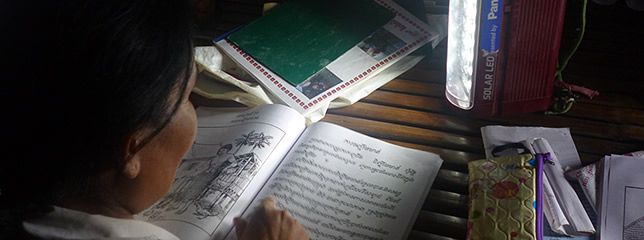
Hello, this is Akira Hoshi reporting from the CSR & Citizenship Group.
I oversaw Panasonic's donation of solar lanterns to NPOs/NGOs active in Cambodia in March 2012. A year has passed since then and I visited Cambodia from the middle of February to the beginning of March to check how the solar lanterns are being put to use. I'm going to report on the situation there.
Although Cambodia has accomplished remarkable economic growth in recent years, the infrastructure for daily life is still not sufficiently developed. In particular, the electrification rate (the proportion of total households supplied with electricity) is 24% for the whole of Cambodia, ranking it the lowest in Asia after Myanmar and East Timor*1. In the rural areas the rate falls to just 13%*2.
So, how are Panasonic's solar lanterns being put to use in the non-electrified areas of Cambodia?
First I headed to a literacy education project run by the Association of School Aid in Cambodia (ASAC).

Left: The donation ceremony (March 2012) / Right: The donated solar lantern
In Cambodia, the major cities, provincial towns and rural communities are each connected by independent small-scale power networks and there is no centralized power network that connects the different regions. Electricity rates are high in comparison to neighboring countries*2 due to small-scale domestic power plants and generators increasing the cost of generation, and power being imported from the neighboring countries of Thailand, Vietnam and Laos.
About two hours by car from the capital, Phnom Penh, an idyllic scene stretches as far as one can see where cows are grazing amidst paddy fields made arid by the dry season.
The houses of this region are all built on stilts as a measure against flooding in the rainy season. Whilst some are fine houses made of concrete, others are more meager, with straw-thatched roofs.
Parts of this area have power poles running along the road, but many of the less well-off people are unable to use the electricity because the charges are approximately twice as expensive as those of the capital, Phnom Penh.
I wondered if Panasonic's technology was useful in the daily lives of the local people.
Feeling both nervous and expectant, I accompanied ASAC coordinator Ms. Fukimi Urata to Cheung Prey village in Batheay District, Kampong Cham Province.
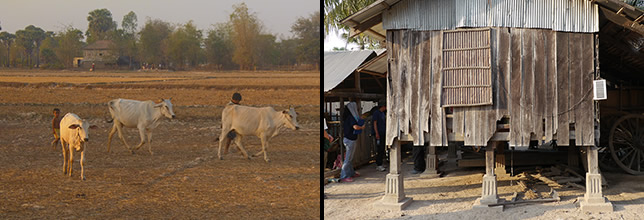
Left: The tranquil rural landscape of Cheung Prey village. / Right: Houses are built on stilts in this region due to the frequent flooding in the rainy season.
ASAC is providing literacy education in the village, teaching a syllabus of up to the level of fourth year elementary school in a different area every six months.
The poor literacy rate in Cambodia is considered to be one of the issues that prevent economic growth in the rural communities. ASAC pays a salary to the literacy education teachers. It seems that the NGO has taken the place of the government in playing an important role in nation building.
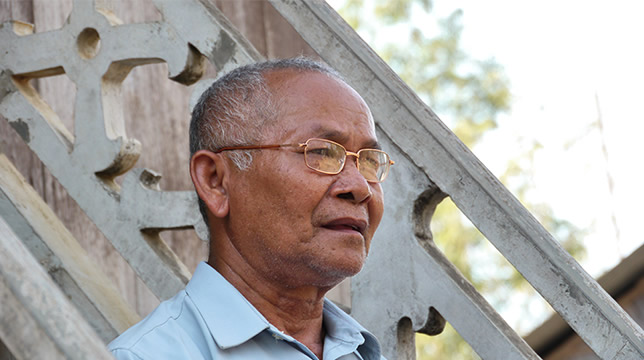
Literacy director Mr. Bun Pheng says, "It is essential for people to be able to read and write if the country is to develop." Having worked passionately in literacy education for almost 20 years from 1995, he now leads the teachers who work in the literacy classes.
The lessons are held six evenings a week from 6PM till 8PM, with the class closed on Sundays and national holidays.
The students of the literacy class in Cheung Prey village are all women and the age range is higher than I expected with one student in her 20s, several in their 30s and over 10 in their 40s and 50s. The lessons cover reading and writing practice using a textbook, and also some simple math problems.
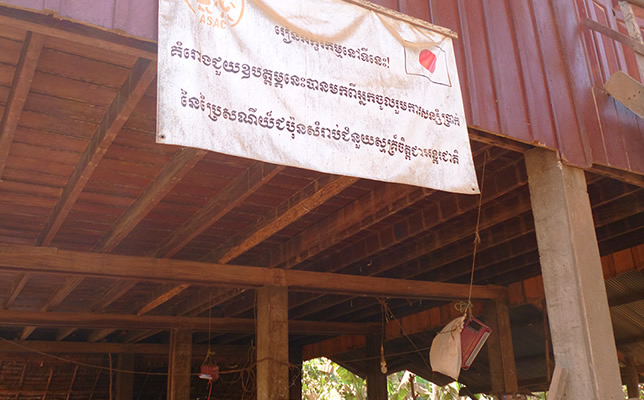
The venue of the literacy class. Solar lanterns hang from the ceiling.
A significant factor is the massacre of scholars and teachers during the Pol Pot regime of the late 1970s, which deprived the people of the opportunity to receive an education. According to a national census in 2008, the National literacy rate is approximately 78% (8.96 million people), but this drops to 75% in agricultural communities in contrast to 90% in urban areas*3. The low literacy rate is assumed to be a factor in the poverty of the rural regions.
The sun goes down at just after six in the evening. As night fell I personally found the village to grow incredibly dark, having become accustomed to the bright nights of the city and there being no street lights in the village.
It's time to start the lesson, and as students carrying solar lanterns come in from different directions, the dark classroom gradually grows light enough to study.
The light of the solar lanterns to which I was normally accustomed felt almost dazzling.
I was very gratified to see everybody treating the solar lanterns with such care - covering them with plastic bags to protect them from rain and dust, and attaching string to make them easier to carry.
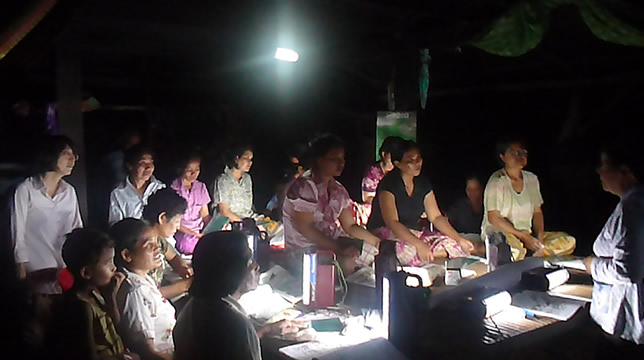
The solar lanterns cast an extremely bright light in the darkness. There is a lively questions-and-answers session and the lesson proceeds with a lively atmosphere from start to finish.
Some of the women of the literacy class bring their children to study with them.
"I want to teach my grandchildren to read and write so that they may become knowledgeable people and have a bright future. If you are clever you will be able to get by in the future--even without a field."
"I'm happy because if my children don't understand something when studying, I am now able to teach them"
If the parents are able to read and write then there will probably be a large impact on their children and grandchildren, in addition to promoting the independence and dignity of the parents.
The solar lanterns are applied in various ways in the daily lives of each household, and are also being used for the self-study of children at night.
Having seen the literacy class of Cheung Prey village firsthand, I was convinced that the solar lanterns were useful in increasing the quality of life of the villagers.
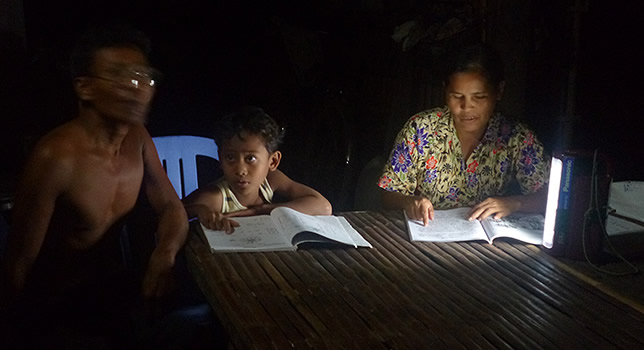
A child studies at home with his mother (a literacy student).
You can also watch the movie below about how solar lanterns are used in ASAC programs. Take a look at it, and listen to the real stories of local people.